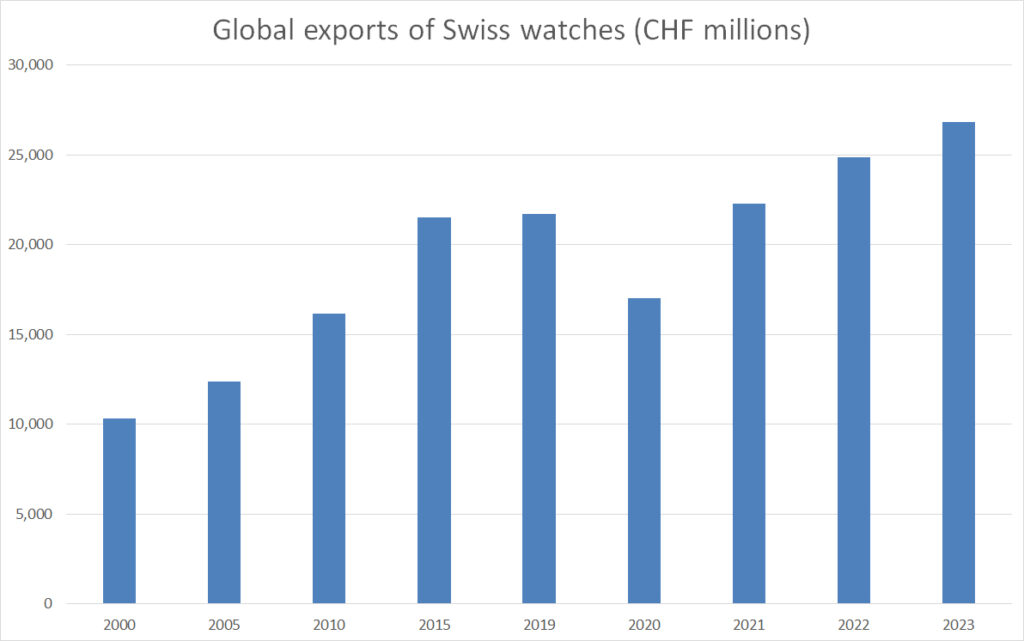The question came right in the dying moments of a debate at Dubai Watch Week: did the panellists believe that during the industry’s hype moment, now passed, that the core watch buyer had been ignored? And if so, was the industry about to take a big hit?
In several days of panelling and debating – such as avowed members of horology’s cosy chumocracy will ever enter into a public debate – it’s unlikely a more pertinent question was asked.
The industry’s purple patch is over and a chill wind is blowing through watchland.
Exports are stalling, brand bosses are feeling the pinch, waiting lists are running shorter, and there are even rumours of clients scoring discounts on Rolex.
Belt-tightening consumers are seeing Switzerland’s low-volume, high-tariff watches for what they have become: painfully, unattractively expensive.
Davide Cerrato, one of the Dubai debaters charged with answering this question, offered the cycle theory by way of response, noting that any market warms and cools with the passing of time and according to macro factors.
And of course he’s right. It does.
He might reasonably have added that the slowdown is a hard luxury issue, not just one for watchmakers.

But he could have been bolder and aired what he has said to me more than once since his appointment as Bremont’s chief executive in the spring, which is that luxury watches are now too pricey and that brands need urgently to reconnect with the lower end of the market.
Cerrato, to his credit, is already on it.
Next year, Bremont will lower its entry price point twice in order to steal the attentions of the client that in the near future will be spending less than before on mechanical watches.
In Bremont’s case, that’s partly motivated by pressure from the brand’s new American investors to scale up, but frankly, the decision is one the brand and the industry should be taking anyway.
Not that there’s much evidence of others following suit.
One brand I spoke to last month told me off-the-record that its strategy is to elevate its position to compete with Audemars Piguet.
Without giving away confidences and while using Morgan Stanley’s figures as an indicator of what that would mean, that brand would have to increase its average retail price by around 40,000 Swiss francs.
At a time when the industry is being accused of alienating its clients with spiralling prices, this is madness.
As a reminder, buyers at the lower end of Swiss watchmaking are abandoning the category in droves.
Last year, Swatch sold a million MoonSwatches, and yet exports of watches with an export value below 200 Swiss francs only climbed by 350,000 units, according to the FHS’s 2022 figures.

The reverse view is that without MoonSwatch, the segment would have shrunk by a further 650,000 units, to add to the 10 million that have evaporated since 2015.
The industry’s solution to this so far has been to produce fewer watches and to charge more for them.
That has yielded record revenues during the short-term hype, but longer term it’s like reducing the 100-metre dash by 10 metres and then celebrating when you break the world record.
Sure, the sub-200 Swiss franc category is an extreme end of the market, and I’m not for a moment saying the top 10 brands should shape their strategies to accommodate models at that level.
The point is to illustrate the continuing trend away from Swiss watchmaking, almost certainly among a younger demographic, which if not addressed now could become enormously damaging.
Cerrato’s new entry-level strategy won’t be alone, but it will be in a minority, barring the continued positioning of a small number of successful affordable luxury brands, such as Tudor and Oris.
I can think of only one other brand boss riffing on the same lines.
In the summer, they told me that in their plans is a new line of more accessible Swiss Made mechanical watches produced under a new dial name, rather than as an extension of their very recognisable company’s current collection.
The intention, they made clear, was not just to stimulate a shrinking market segment but to re-motivate reluctant watch buyers who are coming to see Swiss watches as gaudy, overpriced symbols of excess, rather than aspirational objects.

If those prove to be two lone examples and assuming the second even comes to pass, it’s hard to see how the industry won’t suffer more than it need to in the coming years.
Thanks to a good first half whereby exports continued their upward trajectory (although only really in line with global inflation), this looks set to be the last year of record revenues for the the industry for the foreseeable.
The obvious solution would be to reduce prices, which might be uncomfortable, not least given the towering investments brands have made in infrastructure and marketing, as well as the looming influence of shareholders, but it can be done. Perceptions of weakness will be offset by impressions of value.
Carrying on regardless will accelerate the return of the discount anyway.
Brands have strangled the air out of discount culture over the past six or seven years, buying back stock, reducing references, narrowing distribution and threatening retailers with the parallel promises of account closures and rapidly expanding direct-to-consumer programmes.
But if the market deems prices to be too high, salespeople relying on commission – whether in a multiple or a boutique – will be left with little choice but to accommodate a newly ennobled buyer.
All of which amounts to a significant shift that will be welcomed by consumers while sending a chill down the industry’s spine: a buyer’s market is coming.
Now is the time for the industry to react.


Very enlightening article on the Swiss watch industry’s strategy of raising prices and shrinking the number of units manufactured to grow its top line revenues. The economic law of unintended consequences looks like it is taking effect. A brand like Rolex which was perceived as a brand to strive to and celebrate major events in a collector’s life, is turning its back to focus on the Top 1% of the economic spectrum. Case in point, the ENTRY LEVEL Oyster Perpetual models are totally out of stock at the Authorized Dealer, yet readily available on the grey market above retail. Rolex should maybe study Mercedes Benz that wanted to attract new buyers and developed the C Class entry level model, and produced it in large enough numbers that Mercedes Benz dealers had the model in stock for first time buyers.